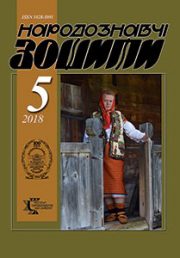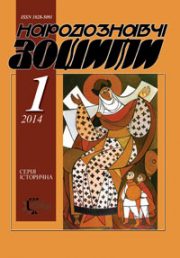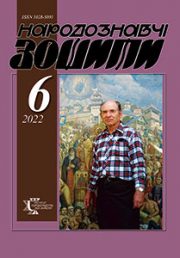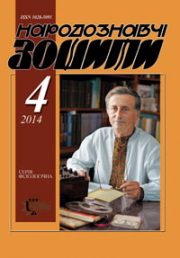The Ethnology Notebooks. 2022. № 5 (167), 1164—1172
UDK [7:338.45]:[904:339.5](5:477) “11/13”
DOI https://doi.org/10.15407/nz2022.05.1164
BYZANTINE TRADITIONS IN DECORATIVE AND APPLIED ART OF GALICIA AND VOLHYNIA IN THE MIDDLE AGES
CHUYKO Oleh
- ORCID ID: https://orcid.org/0000-0003-3713-5593
- Associate Professor, Candidat of Arts (Doctor of Arts Studies),
- Public Higher Education Institution
- Vasyl Stefanyk Precarpathian National University,
- 57, Shevchenko Str., 76000, Ivano-Frankivsk, Ukraine,
- Contacts: e-mail: art.trivium@gmail.com
Abstract. The issue of relations between Byzantium and ancient Kyivan state, in particular such a unique region as Galicia Rus, has long attracted scholars’ attention. There is every reason to conclude that Byzantine-Galician relations developed on a generally friendly basis, due to Volhynia and Galicia, and later the united Principality of Galicia-Volhynia, belonging to the so-called «Byzantine Cultural Circle» (that is, «Byzantine Commonwealth of Nations»). To protect their Danubian possessions from nomadic attacks, rulers of the Byzantine Empire established allied relations with Galician princes.
The aim of the paper is to study specific features of decorative and applied art of Galicia-Volhynia Rus, to highlight issues of correlation between inherited Byzantine cultural norms and unique manifestations of ancient tradition.
The research methodology we have used in this study a number of specific and general scientific methods and approaches — source studies, interpretological, hermeneutic, comparative methods, systems thinking, etc.
Findings. The paper exposes some aspects of cultural interchange between the state of Galicia-Volhynia and Byzantium. We examine, analyze artistic and stylistic features of numerous handicrafts constituting Byzantine imports, define their typological scheme, analogies and the area of their circulation.
Author’s attention is drawn to the corpus of monuments, which are usually referred to as items of personal piety, including encolpion crosses, small steatite icons, pendants, marble breast crosses. We attempt to identify the mediating role of Byzantium (both the metropolis and its eastern provinces) in the artistic genesis of oriental motifs in Europe. We also refer to inter-neighborhood of medieval Rus-Ukraine with Central European states, whose art was marked by Romano-Byzantine style in combination with oriental ornamental elements.
Novelty. The study of the works of art, proves the significance of intercultural interchange, which caused the occurrence of external artistic and stylistic inspirations in the Christian cult objects and amulets attesting to the significance of the Byzantine tradition in the art of the Galicia-Volhynia Rus and its influence on the improvement of professional skills of local masters.
Ruthenian and Greek artists worked using attractive foreign specimens as models. Their artworks are characterized by a high level of skill thanks to the accumulated experience of antiquity and Byzantium. The separate group of small stone sculptures from Halych and northern Bukovyna helps to validate the scholarly reasoning about the existence of Halych school of miniature relief carving and artistic casting.
Received 5.10.2022
REFERENCES
- Hupalo, V. (2002). Zvenyhorod sacraments. Materials and research on the archeology of Precarpathia and Volhynia (Issue 8, pp. 158—169) [in Ukrainian].
- Sveshnikov, I. (1987). Excavations in Zvenyhorod near Lviv. In Archaeological discoveries in 1985 (Pp. 408—409). Moscow: Nauka [in Russian].
- Nikolaeva, T. (1989). Ancient Ruthenian fine stone sculpture of the 11th—15th centuries. Archeology of the USSR. Corpus of Archaeological Sources (E1-60). Moscow: Nauka [in Russian].
- Borovsky, Ya., & Arkhipova, E. (1991). New works of fine stone sculpture from ancient Kyiv (on the materials of excavations). Southern Rus and Byzantium. Collected research works (18th Session of Byzantine Studies) (Pp. 119—131) [in Russian].
- Pyvovarov, S. (2006). Articles of fine stone sculpture from ancient Ruthenian monuments of Bukovyna. Materials and research on the archeology of Precarpathia and Volhynia (Issue 10, pp. 224—230) [in Ukrainian].
- Pekarskaya, L., & Putsko, V. (1991). Byzantine fine sculpture from archaeological finds in Ukraine. Southern Rus and Byzantium (Pp. 24—27) [in Russian].
- Fihol, M. (1997). Art of Ancient Halych. Kyiv: Mystetstvo [in Ukrainian].
- Aulikh, V. (1987). Blacksmiths of gold, silver and copper of ancient Halych. Zhovten, 10, 96—100 [in Ukrainian].
- Aulikh, V. (1990). Halych. In Archeology of Precarpathia, Volhynia and Transcarpathia (Early Slavic and Ancient Ruthenian periods). Kyiv: Naukova dumka [in Russian].
- Sventsitska, V., & Sydor, O. (1990). Age heritage. Ukrainian art of the 14th—18th centuries in the museum collections of Lviv. Lviv: Kamenyar [in Ukrainian].
- Kalavrezou-Maxeiner, J. (1985). Byzantine Icons in Steatite, I—II. (Byzantina Vindobonensia 15). Wien.
- Tymoshchuk, B. (1992). Vasyliv, a town of Galicia Rus. Chernivtsi [in Ukrainian].
- Yesin, P. (1997). Encolpions from archeological finds in Bukovyna and funds of the Chernivtsi Local History Museum. Bukovyna is my native land: materials of the second historical and local history conference of young researchers, students and scientists. Chernivtsi [in Ukrainian].
- Putsko, V. (1994). Byzantine artistic craft and Kyivan Rus. In Proceedings of the Shevchenko Scientific Society. Transactions of the Art History Section (Vol. ССХХVII, pp. 15—28). Lviv [in Ukrainian].
- Sandor, N. Dambo. (1971). Findings of the search for a town in Rakiv. Work of Vojvodina Museum (Vol. 20, pp. 168—173) [in Serbian].
- Putsko, V. (1997). Constantinople masters in Rus before the Mongol-Tatar invasion. Russia and the Christian East (Issue І, pp. 17—23) [in Russian].
- Pyvovarov, S. (2000). Onut, mentioned in the annals. Issues of Ancient and Medieval History, Archaeology and Ethnology (Issue 2, pp. 96—97) [in Ukrainian].
- Didukh, V. (2012). Halych: ancient and modern. Photo album. Halych [in Ukrainian].
- Vozny, I. (1998). Chornivka feudal fortified estate of the 12th—13th centuries. Chernivtsi: Ruta [in Ukrainian].
- Aulich, V. (1985). Explorations in Halych. In Archaeological discoveries of 1983 (Pp. 257—258). Moscow: Nauka [in Russian].
- Baran, V., & Tomenchuk, B. (1998). Findings of research of Halych Archaeological Expedition in 1991—1996. In Halych and the Galician Land: a collection of scientific works (Pp. 10—18). Kyiv; Halych [in Ukrainian].
- Lukomsky, Yu. (1998). Unknown churches at the foot of Princely Halych. In Proceedings of the Shevchenko Scientific Society (Vol. 235, pp. 559—593). Lviv [in Ukrainian].
- Tymoschuk, B. (1998). Terebovl, a town of Galician Rus. In Halych and the Galician Land: a collection of scientific works (Pp. 124—128). Kyiv; Halych [in Ukrainian].
- Sveshnikov, I. (1986). Excavations in the suburb of Zvenyhorod, mentioned in the annals. In Archaeological discoveries of 1984 (Pp. 306—307). Moscow: Nauka [in Russian].
- Ratich, A. (1971). An inscription on an amphora from Zvenyhorod on the Bilka River. In Archaeological discoveries of 1970 (P. 295). Moscow: Nauka [in Russian].
- Shelomyantsiv-Tersky, V. (1982). From the history of the ancient Ruthenian town of Zvenyhorod (based on the materials of archaeological research). Kyivan Rus: Culture, Traditions: Collected scientific works; Ukrainian SSR Academy of Sciences (Pp. 20—28). Institute of Social Sciences. Kyiv: Naukova dumka [in Ukrainian].
- Tymoshchuk, B. (1969). Northern Bukovyna — Land of Slavs. Uzhhorod: Karpaty [in Ukrainian].
- Shchapova, Yu. (1972). Glass of Kyivan Rus. Moscow: Nauka [in Russian].
- Makhnovets, L. (1990). Chronicles of Rus. Kyiv [in Ukra inian].
- Fechner, M. (1982). Silk fabrics in medieval Eastern Europe. Soviet Archaeology, 3, 57—70 [in Russian].
- Pasternak, Ya. (1998). Ancient Halych. Archaeological and historical practices in 1850—1943. Ivano-Frankivsk: Plai [in Ukrainian].
- Petehyrych, V. (2011). Concerning one burial place of the Princely era from Volhynia. Reports and studies on archeology of Precarpathia and Volhynia (Issue 15, pp. 162—172) [in Ukrainian].
- Barvinsky, B. (1996). Ukrainian sphragistic monuments of the 12th—14th centuries. In Proceedings of the Shevchenko Scientific Society. Transactions of the commission for special (auxiliary) historical disciplines (Vol. 231, pp. 5—8). Lviv [in Ukrainian].
- Sydorenko, O. (1992). Ukrainian lands in international trade (ninth — mid-seventeenth centuries). Kyiv [in Ukrainian].
- Janusz, B. (1918). Prehistoric monuments of Eastern Galicia. Krakow: Printing House of the Jagiellonian University, in Lviv [in Polish].
- Antoniewicz, W. (1928). Archeology of Poland: an outline of the prehistoric and early times of the Polish lands. Warsaw: Trzaska, Evert i Michalski [in Polish].
- Rybakov, B. (1951). Applied art and sculpture. In History of the culture of Ancient Rus (Vol. II. pp. 396—464). Moscow; Leningrad: Publishing House of the Academy of Sciences of the USSR [in Russian].
- Makarova, T. (1975). Plated enamels of Ancient Rus. Moscow: Nauka [in Russian].
- Koval, I. (1999). Researcher of the underground archive of Ukraine. Lviv: Misioner [in Ukrainian].
- Perelyhina, A. (2013). Gold enameled Kolt from the collection of the Lviv Historical Museum: history of use and attribution. Museum issues: materials of the scientific conference «Jewelry Art: a glance through the ages» (November 12—14, 2012). Kyiv [in Ukrainian].
- Evans, C., & Wixom, W. (1997). The Glory of Byzantium: Art and Culture of the Middle Byzantine Era, A. D. 843—1261. New York: Metropolitan Museum of Art.
- Tersky, S. (2003). Kolt. In Collection of 110 rarities of the Lviv Historical Museum (P. 19). Lviv: Afisha [in Ukrainian].
- Livokh, R., & Khadukh, A. (2006). Kolts of South-Western Rus. In Slavic-Ruthenian jewelry and its origins (Pp. 140—143). St. Petersburg: Nestor-History [in Russian].







